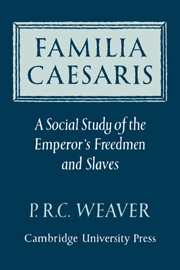Book contents
- Frontmatter
- Contents
- Preface
- Abbreviations
- INTRODUCTION
- PART I NOMENCLATURE AND CHRONOLOGY
- PART II THE FAMILY CIRCLE
- PART III THE EMPEROR'S SERVICE
- 12 Vicarii
- 13 Liberti servus and liberti libertus
- 14 ‘Vicariani’
- 15 The occupational hierarchy: some points of method
- 16 Sub-clerical grades
- 17 Adiutores: junior clerical grades
- 18 Intermediate clerical grades
- 19 Senior clerical grades
- 20 Senior administrative grades: a rationibus, ab epistulis, etc.
- 21 Freedman procurators
- 22 Imperial freedmen and equestrian status: the father of Claudius Etruscus
- CONCLUSION
- APPENDIXES
- Bibliography
- Index
13 - Liberti servus and liberti libertus
Published online by Cambridge University Press: 07 October 2011
- Frontmatter
- Contents
- Preface
- Abbreviations
- INTRODUCTION
- PART I NOMENCLATURE AND CHRONOLOGY
- PART II THE FAMILY CIRCLE
- PART III THE EMPEROR'S SERVICE
- 12 Vicarii
- 13 Liberti servus and liberti libertus
- 14 ‘Vicariani’
- 15 The occupational hierarchy: some points of method
- 16 Sub-clerical grades
- 17 Adiutores: junior clerical grades
- 18 Intermediate clerical grades
- 19 Senior clerical grades
- 20 Senior administrative grades: a rationibus, ab epistulis, etc.
- 21 Freedman procurators
- 22 Imperial freedmen and equestrian status: the father of Claudius Etruscus
- CONCLUSION
- APPENDIXES
- Bibliography
- Index
Summary
It is clear that personal slaves of Imperial slaves must have existed in considerable numbers. What was their social status and how does it compare with that of the vicarii above? To find out this we must examine the inscriptions of the slaves and freedmen of the Augusti liberti, as both personal slave and slave-master, and particularly the latter, had often gained manumission by the time of life at which their inscriptions were put up.
The nomenclature of the Aug(usti) lib(erti) libertus presents few problems. Normally in inscriptions the lib. libertus takes the nomen gentilicium while the freedman-patron is referred to by his cognomen only – no doubt to save space as both have the same nomen; e.g. VI 4281: Ti. Iulius Demetrius Anthi Aug. 1. lib., Ti. Iulius Anthi Aug. 1. lib. Hilario, where the status indication is exhibited in different positions within the same inscription. The terms ‘patronus’, ‘libertus’, etc. are used as normal. But ‘verna’ is frequently not an indication of slave status at all, being in fact used for lib. liberti who died early, or for slaves who may have been manumitted at the point of an early death, or indeed for freeborn children of liberti. As for the slaves of Imperial freedmen, not only are their inscriptions much fewer in number than those of the lib. liberti, but also they mention the nomen of their freedman-master much less frequently – in fact in less than a third of the examples (12/40), including several vernae who are presumably, but not certainly, slaves.
- Type
- Chapter
- Information
- Familia CaesarisA Social Study of the Emperor's Freedmen and Slaves, pp. 207 - 211Publisher: Cambridge University PressPrint publication year: 1972



